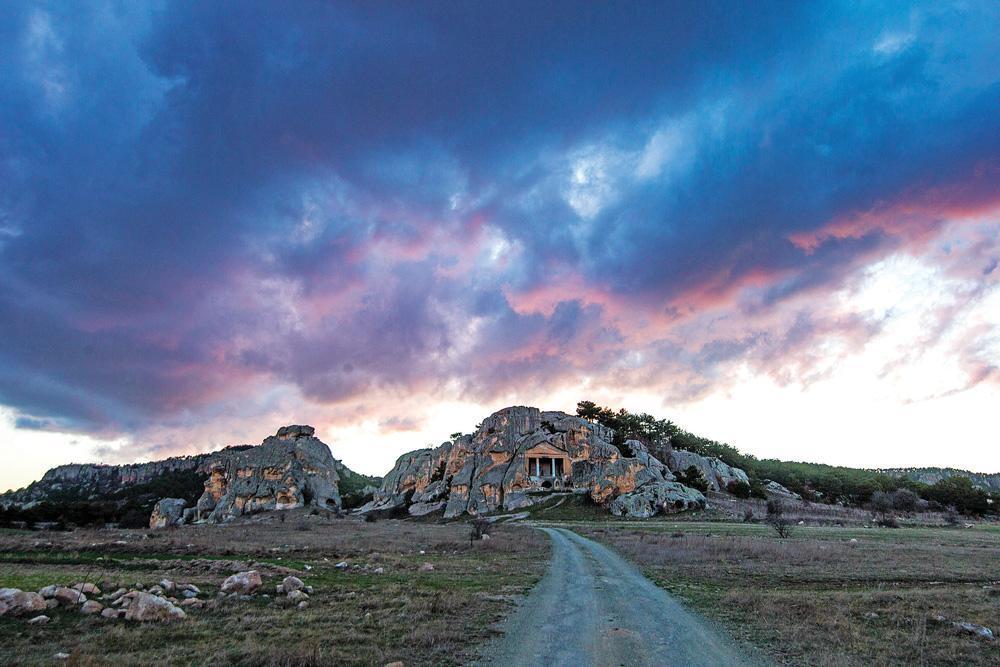
The Phrygian Way, which passes through four provinces in the Aegean and Central Anatolian regions, has become popular among nature lovers with its 506-kilometer route, the third longest hiking trail in Turkey.
The Union for the Protection and Development of Phrygian Cultural Heritage (FRİGKÜM), which was formed in 2009 for the revival of the Phrygian Valley, has realized a project that will enable people to discover the historical, cultural and natural beauties in the region as a whole by walking and biking.
The entire route was marked with red and white colors at international standards to provide safe walks for travelers on the Phrygian Way and informative direction signs were placed at 73 points.
One of the cultural routes in the country, the Phrygian Way passes through eight districts and 44 villages in the province of Afyonkarahisar, Ankara, Eskişehir and Kütahya.
The trail can be reached from three points, including the Yenice Farm in Kütahya, Afyonkarahisar’s Seydiler and the political capital of Phrygians, Gordion (Yassıhöyük) in Ankara’s Polatlı, and merges in Yazılıkaya village in the Phrygians’ religious center (Midas) in Eskişehir’s Han district.
The Phrygian Valley, with its rock formations from the Phrygians, rock monuments, rock tombs, churches and chapels, fairy chimneys and other natural beauties, is one of the most charming 10 valleys in Turkey.
Speaking to state-run Anadolu Agency, FRİGKÜM Team President Afyonkarahisar Governor Mustafa Tutulmaz said enough work had not been carried out in the past to bring the Phrygian Valley in tourism, and that FRİGKÜM was carrying out works for the region to serve the public and tourism sector.
Tutulmaz said they had made big progress in the works.
“Recently, the relevant ministries, FRİGKÜM and the governor’s office have carried out important works. First, the Environment and Urban Planning Ministry made a master plan of the region. As part of this plan, 73 historical artifacts were detected and an infrastructure was made for what could be done for the future. With an investment of 3 million Turkish liras this year, the ministry initiated work to make better use of the valleys. The Phrygian Valley was launched as a natural park by the Forestry and Water Affairs Ministry and the landscaping still continues,” he said.
The FRİGKÜM team president said an allowance of 9 million liras was allocated for the infrastructural works to be carried out in the region. One of the most important features of the region is thermal water resources, he said.
Since the Phrygians, it had been used for healing purposes and the region became known as Healing Phrygia. Because of this, interest in thermal resources in the Afyonkarahisar, Eskişehir and Kütahya provinces will increase,” said Tutulmaz.
Tutulmaz noted that various activities were being organized in the Phrygian area
“Now, thanks to the project presented by the İhsaniye Governor’s Office and realized with the support of FRİGKÜM and the Afyonkarahisar Special Provincial Administration, a dream has come true. The Phrygian Valley is the new spot for alternative tourism with log cabins, ATVs, bicycles and boat tours on Emre Lake. Similar projects will also be carried out in the Kütahya and Eskişehir parts of the valley this year,” he said.
Phrygian Valley
The Phrygian Valley has been home to a number of communities since ancient times. The area was dominated by the Phrygians between 900 B.C. and 600 B.C. but was dealt a fatal blow in 676 B.C. by the Cimmerians, who came from further east beyond Anatolia. Later, the area fell under Roman control
The Phrygians experienced a golden age during the reign of King Midas, who ruled from Gordion—close to present-day Ankara—and is thought to have lived between 738 B.C. and 696 B.C.